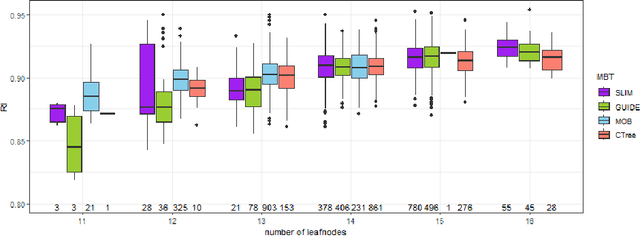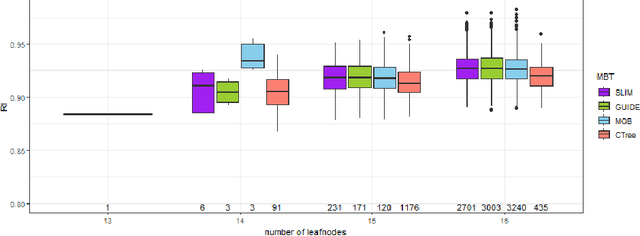Giuseppe Casalicchio
Privilege Scores
Feb 03, 2025



Abstract:Bias-transforming methods of fairness-aware machine learning aim to correct a non-neutral status quo with respect to a protected attribute (PA). Current methods, however, lack an explicit formulation of what drives non-neutrality. We introduce privilege scores (PS) to measure PA-related privilege by comparing the model predictions in the real world with those in a fair world in which the influence of the PA is removed. At the individual level, PS can identify individuals who qualify for affirmative action; at the global level, PS can inform bias-transforming policies. After presenting estimation methods for PS, we propose privilege score contributions (PSCs), an interpretation method that attributes the origin of privilege to mediating features and direct effects. We provide confidence intervals for both PS and PSCs. Experiments on simulated and real-world data demonstrate the broad applicability of our methods and provide novel insights into gender and racial privilege in mortgage and college admissions applications.
Efficient and Accurate Explanation Estimation with Distribution Compression
Jun 26, 2024Abstract:Exact computation of various machine learning explanations requires numerous model evaluations and in extreme cases becomes impractical. The computational cost of approximation increases with an ever-increasing size of data and model parameters. Many heuristics have been proposed to approximate post-hoc explanations efficiently. This paper shows that the standard i.i.d. sampling used in a broad spectrum of algorithms for explanation estimation leads to an approximation error worthy of improvement. To this end, we introduce Compress Then Explain (CTE), a new paradigm for more efficient and accurate explanation estimation. CTE uses distribution compression through kernel thinning to obtain a data sample that best approximates the marginal distribution. We show that CTE improves the estimation of removal-based local and global explanations with negligible computational overhead. It often achieves an on-par explanation approximation error using 2-3x less samples, i.e. requiring 2-3x less model evaluations. CTE is a simple, yet powerful, plug-in for any explanation method that now relies on i.i.d. sampling.
On the Robustness of Global Feature Effect Explanations
Jun 13, 2024Abstract:We study the robustness of global post-hoc explanations for predictive models trained on tabular data. Effects of predictor features in black-box supervised learning are an essential diagnostic tool for model debugging and scientific discovery in applied sciences. However, how vulnerable they are to data and model perturbations remains an open research question. We introduce several theoretical bounds for evaluating the robustness of partial dependence plots and accumulated local effects. Our experimental results with synthetic and real-world datasets quantify the gap between the best and worst-case scenarios of (mis)interpreting machine learning predictions globally.
Position Paper: Rethinking Empirical Research in Machine Learning: Addressing Epistemic and Methodological Challenges of Experimentation
May 03, 2024Abstract:We warn against a common but incomplete understanding of empirical research in machine learning (ML) that leads to non-replicable results, makes findings unreliable, and threatens to undermine progress in the field. To overcome this alarming situation, we call for more awareness of the plurality of ways of gaining knowledge experimentally but also of some epistemic limitations. In particular, we argue most current empirical ML research is fashioned as confirmatory research while it should rather be considered exploratory.
mlr3summary: Concise and interpretable summaries for machine learning models
Apr 25, 2024
Abstract:This work introduces a novel R package for concise, informative summaries of machine learning models. We take inspiration from the summary function for (generalized) linear models in R, but extend it in several directions: First, our summary function is model-agnostic and provides a unified summary output also for non-parametric machine learning models; Second, the summary output is more extensive and customizable -- it comprises information on the dataset, model performance, model complexity, model's estimated feature importances, feature effects, and fairness metrics; Third, models are evaluated based on resampling strategies for unbiased estimates of model performances, feature importances, etc. Overall, the clear, structured output should help to enhance and expedite the model selection process, making it a helpful tool for practitioners and researchers alike.
A Guide to Feature Importance Methods for Scientific Inference
Apr 19, 2024Abstract:While machine learning (ML) models are increasingly used due to their high predictive power, their use in understanding the data-generating process (DGP) is limited. Understanding the DGP requires insights into feature-target associations, which many ML models cannot directly provide, due to their opaque internal mechanisms. Feature importance (FI) methods provide useful insights into the DGP under certain conditions. Since the results of different FI methods have different interpretations, selecting the correct FI method for a concrete use case is crucial and still requires expert knowledge. This paper serves as a comprehensive guide to help understand the different interpretations of FI methods. Through an extensive review of FI methods and providing new proofs regarding their interpretation, we facilitate a thorough understanding of these methods and formulate concrete recommendations for scientific inference. We conclude by discussing options for FI uncertainty estimation and point to directions for future research aiming at full statistical inference from black-box ML models.
Effector: A Python package for regional explanations
Apr 03, 2024Abstract:Global feature effect methods explain a model outputting one plot per feature. The plot shows the average effect of the feature on the output, like the effect of age on the annual income. However, average effects may be misleading when derived from local effects that are heterogeneous, i.e., they significantly deviate from the average. To decrease the heterogeneity, regional effects provide multiple plots per feature, each representing the average effect within a specific subspace. For interpretability, subspaces are defined as hyperrectangles defined by a chain of logical rules, like age's effect on annual income separately for males and females and different levels of professional experience. We introduce Effector, a Python library dedicated to regional feature effects. Effector implements well-established global effect methods, assesses the heterogeneity of each method and, based on that, provides regional effects. Effector automatically detects subspaces where regional effects have reduced heterogeneity. All global and regional effect methods share a common API, facilitating comparisons between them. Moreover, the library's interface is extensible so new methods can be easily added and benchmarked. The library has been thoroughly tested, ships with many tutorials (https://xai-effector.github.io/) and is available under an open-source license at PyPi (https://pypi.org/project/effector/) and Github (https://github.com/givasile/effector).
Explaining Bayesian Optimization by Shapley Values Facilitates Human-AI Collaboration
Mar 08, 2024



Abstract:Bayesian optimization (BO) with Gaussian processes (GP) has become an indispensable algorithm for black box optimization problems. Not without a dash of irony, BO is often considered a black box itself, lacking ways to provide reasons as to why certain parameters are proposed to be evaluated. This is particularly relevant in human-in-the-loop applications of BO, such as in robotics. We address this issue by proposing ShapleyBO, a framework for interpreting BO's proposals by game-theoretic Shapley values.They quantify each parameter's contribution to BO's acquisition function. Exploiting the linearity of Shapley values, we are further able to identify how strongly each parameter drives BO's exploration and exploitation for additive acquisition functions like the confidence bound. We also show that ShapleyBO can disentangle the contributions to exploration into those that explore aleatoric and epistemic uncertainty. Moreover, our method gives rise to a ShapleyBO-assisted human machine interface (HMI), allowing users to interfere with BO in case proposals do not align with human reasoning. We demonstrate this HMI's benefits for the use case of personalizing wearable robotic devices (assistive back exosuits) by human-in-the-loop BO. Results suggest human-BO teams with access to ShapleyBO can achieve lower regret than teams without.
Position Paper: Bridging the Gap Between Machine Learning and Sensitivity Analysis
Dec 20, 2023Abstract:We argue that interpretations of machine learning (ML) models or the model-building process can bee seen as a form of sensitivity analysis (SA), a general methodology used to explain complex systems in many fields such as environmental modeling, engineering, or economics. We address both researchers and practitioners, calling attention to the benefits of a unified SA-based view of explanations in ML and the necessity to fully credit related work. We bridge the gap between both fields by formally describing how (a) the ML process is a system suitable for SA, (b) how existing ML interpretation methods relate to this perspective, and (c) how other SA techniques could be applied to ML.
Leveraging Model-based Trees as Interpretable Surrogate Models for Model Distillation
Oct 04, 2023



Abstract:Surrogate models play a crucial role in retrospectively interpreting complex and powerful black box machine learning models via model distillation. This paper focuses on using model-based trees as surrogate models which partition the feature space into interpretable regions via decision rules. Within each region, interpretable models based on additive main effects are used to approximate the behavior of the black box model, striking for an optimal balance between interpretability and performance. Four model-based tree algorithms, namely SLIM, GUIDE, MOB, and CTree, are compared regarding their ability to generate such surrogate models. We investigate fidelity, interpretability, stability, and the algorithms' capability to capture interaction effects through appropriate splits. Based on our comprehensive analyses, we finally provide an overview of user-specific recommendations.
 Add to Chrome
Add to Chrome Add to Firefox
Add to Firefox Add to Edge
Add to Edge